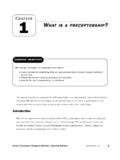Transcription of The Science of Human Physical Activity
1 Introduction to Kinesiology:The Science of Human Physical Activity by Stephen WallaceIncluded in this preview: Copyright Page Table of Contents Excerpt of chapter 1 For additional information on adopting this book for your class, please contact us at x501 or via e-mail at Science OF Human Physical ACTIVITYS tephen WallaceCopyright 2011 University Readers Inc. All rights reserved. No part of this publication may be reprinted, reproduced, transmitted, or utilized in any form or by any electronic, mechanical, or other means, now known or hereafter invented, including photocopying, microfi lming, and recording, or in any information retrieval system without the written permission of University Readers, published in the United States of America in 2011 by Cognella, a division of University Readers, Notice: Product or corporate names may be trademarks or registered trademarks, and are used only for identifi cation and explanation without intent to 14 13 12 11 1 2 3 4 5 Printed in the United States of AmericaISBN: 978-1-60927-801-4 Cover photograph, Makaila Wallace, by Michael vCHAPTER ONEK inesiology.
2 The Emergence of a New Field of Study 1 chapter TWOThe History of Kinesiology 21 chapter THREEA natomical and Physiological Systems 67 chapter FOURE xercise Physiology Foundations 107 chapter FIVEB iomechanical Foundations 137 chapter SIXM otor Control and Motor Learning Foundations 163 chapter SEVENP sychological Foundations 203 chapter EIGHTD evelopmental Foundations 235 CONTENTSCHAPTER NINES ociocultural Foundations 271 chapter TENE pilogue 299 PrefaceFor humans and other animals, movement is critical for survival. Without movement, our ability to communicate through speech and gesturing to satisfy basic needs would be lost. Even a lack of adequate movement or Physical Activity negatively impacts our physiological and psychologi-cal states. Humans incarcerated for long time periods without the opportunity for Physical Activity suff er physiological and psychological deterioration.
3 On the other hand, optimal amounts of Physical Activity pro-vide benefi ts to our Physical and mental conditions. In addition, how we actually produce movement is of great importance to coaches and teachers of aspiring athletes, to Physical therapists who aid in the rehabili-tation of physically impaired individuals, to engineers and ergonomists who build machines and construct work environments to match Human abilities, and to scientists trying to unravel the great mysteries of how skilled movement is acquired. Given the importance of movement to our very survival and to our quality of life, the scientifi c study of Human movement is clearly warranted. In short, movement matters. Kinesiology, derived from the Greek terms kinesis (movement) and logos (the study of ), is a fi eld dedi-cated to the study of Human Physical Activity . Th e earlier use of the term kinesiology was restricted to applied biomechanics, but recently it is becoming more common to use the term for representing the entire scope of the study of Human movement and Physical is this scope?
4 All movements, large and small, simple and elaborate, are the result of complex interactions of anatomical (bones, muscles, tendons, etc.) and neurophysiological components. Th e mil-lions of nerve cells in our nervous system allow us to formulate intentional behavior, react to stimuli and maintain balance and posture. Our anatomy serves as the foundation for all movement. Th us, Human anatomy and physiology are essential elements of the fi eld of study we call kinesiology. Biomechanical prin-ciples, adapted from physics, allow us to characterize the forces produced by the body and those that act on the body, such as gravity, as well as provide detailed description and effi ciency of movement. Concepts in motor control and motor learning are required to help us understand how we coordinate movements and acquire new motor skills. Psychological factors, such as motivation and stress, are known to infl u-ence the quality of performance and determine our desire or aversion to participate in Physical Activity .
5 Our Physical and mental conditions are also aff ected by the aging process. A life-span developmental Preface vvi Preface kinesiology perspective is required to understand refl exive movement, the development of intentional skilled movement, and the decline in physiological and behavioral functions with age. Understanding of the sociocultural aspects of movement and Physical Activity is needed to answer questions related to dif-ferences in Physical Activity patterns of boys and girls, of diff erent racial groups and older adults, and the infl uence of sport on the adoption of a physically ac-tive lifestyle. Another important element of any fi eld of study is to have an understanding of its history. Identifying the important people and events that have infl uenced the development of kinesiology is useful in acquiring a perspective of how the fi eld got to where it is, as well as trying to understand where it is going.
6 Related to the historical understanding of kinesiology is the philosophical understanding of kinesiology as a fi eld of study. In what ways can we view kinesiology as a fi eld of study? For example, is kinesiology simply a collection of separate areas of study (biomechanics, exercise physiology, etc.), or does kinesiology provide a home for all the various subfi elds, such that integra-tion of the contents of the subfi elds can occur? Th us, an understanding of how we move, what motivates our actions, and the physiological and psychological benefi ts of Physical Activity requires a fi rm grounding in the areas of Human anatomy and physiology, biomechanics, exercise physiology, motor learning and motor control, sport and exercise psy-chology, motor development, and the sociocultural aspects of Human movement. It is also important to have a historical and philosophical perspective on Human Physical Activity .
7 Th e fi eld of study called kinesiology provides a scholarly home for these areas. Today, many major universities in the country have a kinesiology department consisting of scholars in most or all of the above areas. Other related department names are used to describe this fi eld, such as Exercise and Sport Science , Human Movement Studies, and so forth. As the fi eld of kinesiology continues to develop, I believe it is important to provide an introductory text that reviews the major concepts, principles, and experimental fi ndings for the curious yet serious student. Most major fi elds of study have a text(s) that provides this type of information in a readable yet sci-entifi cally rigorous format for the student. However, there are only a few texts today that specifi cally focus on the fi eld of kinesiology as described above or that provide suitable introductory information.
8 Th is text attempts to address this need. Th is text is primarily designed for the student who either intends to enter the fi eld of kinesiology or is simply curious about the fi eld. It is my hope that this text will provide a scholarly introduction to the fi eld of kinesiology for those students interested in careers in Physical education, coaching, ergonomics, physi-cal therapy, sport psychology, medicine and other health-related professions, for example. Th e text is also designed to help prepare students for future core courses taken in kinesiology such as biomechanics, exercise physiology, etc. Th e ten chapters in the text are arranged in the or-der that I have taught an Introduction to Kinesiology class in the past. Th e order of the chapters could be changed to fi t the needs of the instructor. chapter One, Kinesiology: Th e Emergence of a New Field of Study, discusses the focus of kinesiology, defi nes the various subfi elds, and describes the cross- and interdisciplinary nature of kinesiological inquiry.
9 In addition, chapter One identifi es the links to professional and performance areas, outlines a typical kinesiology degree, and describes career options for the undergraduate kinesiology student. chapter Two, Th e History of Kinesiology, pro-vides an account of the promotion of Physical Activity in diff erent civilizations and cultures throughout his-tory. Th is chapter also identifi es important names and events of scientifi c contributions to our understanding of the Human engaged in Physical Activity , and sum-marizes the development of kinesiology as a fi eld of study. chapter Two is presented in a chronological (as opposed to a thematic) framework and is an attempt to provide some useful information on the develop-ment of inquiry into the study of and participation in Physical Activity throughout history. chapter Th ree, Anatomical and Physiological Systems, provides background information for the beginning student on several physiological systems of the Human body.
10 Th e knowledgeable reader will Preface viinotice that not all physiological systems are discussed. Only those systems I thought would be helpful in un-derstanding the subsequent chapters were included. chapter Four, Exercise Physiology Foundation, provides information on energy utilization during movement and exercise, cardiovascular changes with exercise, and ventilatory changes with exercise. Th is chapter also provides some discussion of the impor-tance of Physical Activity and exercise to health and fi tness. chapter Five, Biomechanical Foundation, describes types of Human motions, as well as linear and angular kinetics and kinematics. Th e chapter also discusses the nature of Newton s three laws of motion and how they may be applied to Human motion. chapter Six, Motor Control and Motor Learning Foundation, gives an overview of the neuromuscular system and briefl y describes some major models of motor control.














